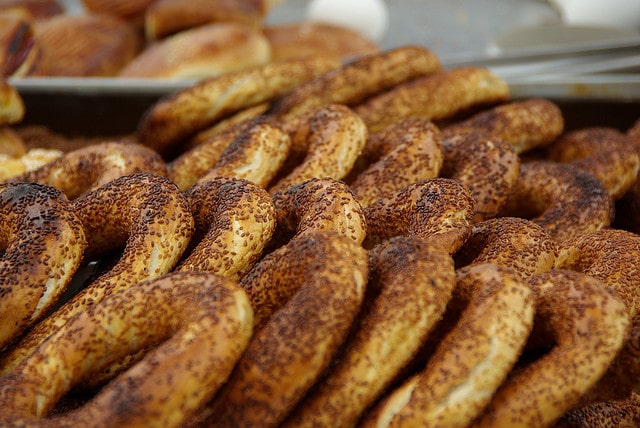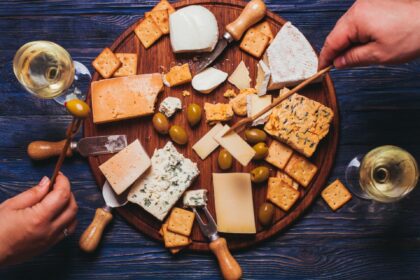“Tonight I’m going to take you away from the touristy restaurants and show you what and where the locals eat.”
I’m currently on an Istanbul by Night: Turkish Food Tour with my local guide, Yuke Celik. She’s a pretty 26-year-old with a passion for local culture, especially when it comes to traditional Turkish food and drink.
After showing me around the main hub of the city, Taksim Square, with its Atatürk Cultural Center, Independence Monument and mix of churches, mosques and temples we stop on Istiklal Street — the most popular place to go for food, shopping and nightlife — to pick up our first morsel for the evening, simit.
A popular local street food typically eaten for breakfast or a quick snack on the go, simit is a crispy circular bread encrusted with sesame seeds.
Instead of quickly scarfing it down, however, we head down Bekar Street to visit Oflular Kiraathanesi, one of Istanbul’s many “men only” hangouts.
While it’s not forbidden for women to enter — obviously, since Yuke and I are women — they are not really welcome; however, as I am on a local Istanbul food tour the manager gets a kick out of it. The venue is small, with men drinking tea, watching the horse races on television and playing games like backgammon and cards.
Yuke and I sit down to a game of “Okey” which is kind of like Rummy as you pick upside down tiles and try to form different color number matches and same color number sequences. As we’re playing and enjoying our simit, the manager brings over small tulip-shaped glasses of Turkish tea.
This traditional tea is a black tea drank without milk that is produced on the eastern Black Sea coast. It’s extremely strong, and some people like to add extra hot water or sugar to dilute it. In Turkey, it is customary when your glass is empty to place your spoon inside if you would like more, or upside over the top if you’re finished.
Because I’m trying to save room for the following food and drink stops I somehow manage to not finish my simit; however, when I go to throw the remaining bread in the trash Yuke stops me.
“Nobody here wastes food,” she explains. “There are so many stray cats. Not to mention since we opened the Syrian border the streets have hungry beggars. You can leave it on a paper bag on the street corner and someone will eat it.”
This idea blows my mind. I’m from New York City where the streets are feel of homeless people; yet, everyone wastes food all the time. Imagine if we adopted this mentality?
After I’ve found a scrawny cat in need of some nourishment to feed the rest of my simit to, we continue our epicurious journey into local culture.
Although Istiklal Street is full of both tourists and locals, many visitors refrain from veering off the l.4-kilometer (0.6-mile) avenue and down the narrow side streets full of local restaurants, bars and bakeries.
These alleyways are full of locals sitting outside on low tables and chairs, sipping tea and coffee, smoking shisha, listening to saz music and gabbing loudly.
Despite the fact it’s close to the tourist street, it feels like a totally different world.
“Here’s our next stop,” says Yuke, bringing us in front of a restaurant called Umut Ocakbasi on Hasnun Galup Street.
While the bottom floor is a simple white room with tables and portraits of Mustafa Kemal Atatürk, the first president of Turkey, the upstairs is an open-air rooftop patio where you can see meats being grilled “fireplace-style” on open coals using skewers.
The restaurant uses only the parts of the meat that are tender without muscle, like the lower back of the cow, and is called Cop Sis (rubbish meat) because it is served in tiny pieces.
To enjoy the delicacy Turkish style, you put a tortilla-like bread flat in the palm of your hand and spoon in some meat; tomato; hot pepper; spices like chili, cumin and thyme; parsley with onion and sumac; a mix of smashed tomatoes, onions and spices called esme; and a mix of smashed baked eggplant with chili and olives called patlican esme.
We pair the finger-food meal with Raki, a strong anise-flavored alcohol which you add water to to create a milky licorice tasting libation.
Next it’s time for a traditional mezze (small plate) many Americans may find unusual, fresh melon topped with goat cheese, tomato and cucumber.
We enjoy this at Kimene Restaurant — which literally means “Who Cares” — which features outdoor and indoor seating as well as Boheme crystal chandeliers to match its laid-back attitude and old time feel (the restaurant has been open since 1963).
The goat cheese is thicker and tangier than what I’m used to back home, but in a good way, and contrasts with the melon for a well-balanced flavor. Suddenly, the waiter brings over glasses of Efes Pilsen beer.
“Şerefe!” shouts Yuke, clinking my glass. “It means ‘to your honor’ or ‘cheers’ in Turkish.”
Once we’re finished, Yuke smiles mischievously. “For the next meal do you want me to tell you what this interesting dish is before you eat it or after?”
The glint in her eye makes me a little uneasy. “Ummm, after.”
We head to Şampiyon Kokoreç (Zühtüpaşa Mh. 34724 Kadıköy), a restaurant that’s been open since 1962 and serves the aptly named kokorec, a popular Turkish street food.
I’m handed a sandwich full of tiny chopped up pieces of meat, spices and peppers, taking a bite before I can think twice. I try to pinpoint what the mix of spice and tang could be. It almost reminds me of shellfish, although it’s clearly red meat as it looks almost like a taco with thicker bread.
“Is it balls?” I ask, trying to think of something crazy.
Yuke laughs. “No, close but a little more tame…Intestines.”
As I’ve eaten innerds that actually looked like long intestines throughout my time spent in South America, I can honestly say this is a step up.
It’s delicious, and I finish every last bite (and even use the traditional Lion Cicegi Kolonyasi, a mix of lemon and alcohol, to clean my hands at the end).
Interestingly, the chefs who make this dish sing and make music as they’re cooking, chanting about how the European Union won’t accept them because they eat such a strange delicacy.
Although I’m feeling invincible and like I can handle anything our next meal turns my stomach a bit, although I’m happy to have sampled it: Tripe Soup.
Tripe is a rubbery cow stomach lining, and while the taste can be enjoyable it’s the smell that really gets me. We sample the dish at Cumhuriyet Iskembe Salonu (Dudu Odaları Sok. No: 15/B), known for making the freshest tripe soup in the country.
It’s typical to add garlic, vinegar and chili to offset the smell and overpowering taste, and according to Yuke is common to eat when you’re drunk because nobody will know you’ve been drinking since it’s odor is stronger than that of alcohol.
We end the night with a pick me up at Hazzo Pulo, an indoor/outdoor venue known for its strong Turkish coffee and fragrant shisha.
Apparently, a good Turkish coffee has a lot of bubbles and is flavored with cardamon. It plays an important part in Turkish culture, especially when it comes to marriage proposals.
When a man is proposing to a woman he will go to her house to ask for her hand in marriage, and she will prepare coffee for him and the rest of her family.
As she prepares the coffee people will check it for the right amount of bubbles to see if she is a good housewife. Moreover, there are fortune tellers around Istanbul — look for the “Fal” sign outside — who can read your future by looking at the images depicted at the bottom of a cup of coffee after turning it upside down on a plate.
On the way home we walk again down bustling Istiklal Street, which for 10:30pm at night on a Sunday night is extremely happening, full of party-goers, packed restaurants, clubs and shops that stay open until 3am.
I spot an energetic ice cream maker using a metal stick to pound on the dessert before pulling the frozen cream up and twirling it like a pizza. The small shop was called Dondurma and serves a special type of ice cream crafted with goats milk cheese for an extra creamy and tangy dessert.
If you’re ever in Istanbul and having a craving for sweets, I recommend you sample this treat as well as Turkish Delights from the nearby Ali Muhıddin Hacı Bekir (Istiklal Cad. No. 83/6,), which has been in business since 1777 and sells a variety of flavors of the gelatin candies made with sugar, honey, fruit and nuts.
After taking this delicious tour through Istanbul you’ll not only feel satisfied, but will have truly experienced Istanbul’s culinary culture like a local.
Travel Tip: When looking for a great place to eat in Istanbul check to see if there is a picture of a white lily outside the door. This means the eatery has been highly rated. Moreover, there are an array of delicious and budget-friendly street foods to sample that you’ll see everywhere, some of which include simit, doner, corn on the cob, mussels, kofte, pide and kestane.
Jessica Festa
Latest posts by Jessica Festa (see all)
- A Culturally-Immersive Adventure In Mongolia’s Altai Mountains - Jul 8, 2023
- This Recipe Sharing Platform Supports Women In The Culinary Industry (Labneh Recipe Included!) - Nov 5, 2020
- Hiking The Mohare Danda Community Eco-Trek In Nepal - Jun 3, 2020
- 6 Important Questions For Choosing A Responsible Yoga Retreat - May 18, 2020
- How To Create & Grow A Profitable Blogging Business (Ethically) - Jan 18, 2020












Jessica, I am from Turkey and I miss my home town Izmir very much. Reading your adventures and the food that you have tasted makes me so home sick but delighted that you have shared this with us. thank you!!
PS. You certainly are braver than me by trying the tripe soup and the intestine sandwich. Never had the gut but everyone else swears by it:-)
@Yasemin: Thank you for the kind words. I will admit it was not my favorite dish of the trip 😉 ha